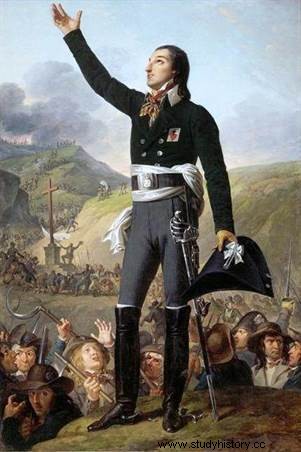 Hero of the Vendée revolt of 1793, nicknamed by some the "saint of Poitou", Louis- Marie de Ségales, Marquis de Lescure was for his contemporaries a model of temperance, courage and piety. A charismatic figure who truly achieves heroic status after the death of the Marquis in 1794, carried off by a Republican bullet. In search of a symbol, Louis XVIII will give pride of place to the leaders of the Vendée during the Restoration, he will have a series of paintings produced, including this one entrusted to Robert Lefèvre and taking up a mythical scene from the Battle of Fontenay.
Hero of the Vendée revolt of 1793, nicknamed by some the "saint of Poitou", Louis- Marie de Ségales, Marquis de Lescure was for his contemporaries a model of temperance, courage and piety. A charismatic figure who truly achieves heroic status after the death of the Marquis in 1794, carried off by a Republican bullet. In search of a symbol, Louis XVIII will give pride of place to the leaders of the Vendée during the Restoration, he will have a series of paintings produced, including this one entrusted to Robert Lefèvre and taking up a mythical scene from the Battle of Fontenay.
Louis de Lescure, hero of the military Vendée
Louis-Marie de Ségales, Marquis de Lescure comes from a noble family of Poitou. A student at the military school, he showed austere piety and great erudition. Humanist, far from being a fierce opponent of the new ideas of the Revolution, he

A political work
Under the restoration, the Vendée chefs were given pride of place and Robert Lefèvre, a famous portrait painter, was commissioned to produce the painting by Monsieur de Lescure, which he completed in 1818. The will of the work is purely political, it is a question of making forget a little the republican and imperial epic by exalting some royalist heroes. Louis XVIII commissioned a whole series of portraits of Vendée leaders in 1816. The works were exhibited to the public at successive Salons before being installed in the Palais de Saint-Cloud. The political character of these works being beyond doubt, they were relegated to the reserves of the Louvre following the Revolution of 1830. They did not come out until 1870 and are now visible at the Musée de Cholet.
Chosen Scene:Courage and Piety
The scene that the painter chooses to represent brings out two values characteristic of the Vendée camps and that the restored monarchy encourages:courage and piety.
This is a moment chosen from the Battle of Fontenay (May 25, 1793). The Vendeans had been beaten a few days earlier in this same place by the army of General Chalbos, regrouped and reinforced they launched a victorious counter-attack and recovered the Marie-Jeanne, an artillery piece which had become the "mascot" of the insurgents . During this battle Lescure's men seem to hesitate and he advances alone against the enemy, the Republican grapeshot breaks his stirrup (detail shown on the table)! The peasants then join him in the race but suddenly stop in front of a cross to pray (background of the painting that the combatant at the bottom left invites us to look at)… Monsieur de Beugé would then have wanted to urge them to resume the assault when Lescure would have stopped him saying "No, let them pray, they'll only fight better! ". Lescure is represented at this moment, his hand and his eyes turned towards the sky, joining his prayer to that of the peasants for victory.
